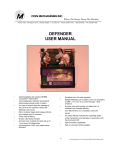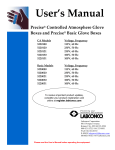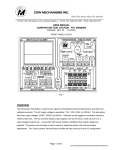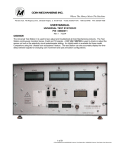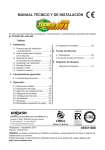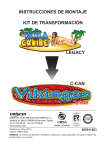Download DEFENDER USER MANUAL
Transcript
Where The Money Meets The Machine PO Box 5128, 400 Regency Drive, Glendale Heights, IL 60139-5128 VOICE: 630/924-7070 1-800-323-6498 FAX: 630/924-7088 DEFENDER USER MANUAL • • • • • • • • Interchangeable with existing Comparitor® mechanisms Uses independent diameter sensing that discriminates shaved coins or tokens An array of sensors track the passage of the coin from the moment it enters the Defender until it exits Micro controller based technology performs coin analysis and I/O functions Fixed credit buffering Bi-color LED status indicator Accurate coin counting at a feed rate up to 1 coin every 50 milliseconds All mechanisms 100% coin tested before shipment • • • • • • • 1 Socketed micro for easy upgrades Multiple Defender part numbers cover coin diameters of .698” / 17.73 mm (U.S. Dime) through 1.50” / 38.10 mm. Dynamic coin path sensing can determine if a validated coin changes direction. Coin Mechanisms, Inc. proprietary coin path sensor. An output (Ready) indicates the operating status of the mechanism, and operates in conjunction with the Bi-colored LED. Optic emulation capabilities. High or Low logic Inhibit available © Coin Mechanisms Inc. Document # 09300339 Rev 1 May 2003 DEFENDER BASIC THEORY OF OPERATION BASIC THEORY OF OPERATION: The DEFENDER is an Electromechanical Coin Mechanism designed to accept a single denomination metal coin. The DEFENDER must be mounted in an up-right position so that gravity pulls a coin downward through the mechanism. The mechanism has a single top coin entry slot located on the top left side. There are two coin exits at the bottom of the mechanism. In a normal straight drop unit an accepted good coin exits the mechanism on the left side, directly below the top entry slot, and rejected bad coins exit on the right side. In a reverse logic mechanism, an accepted good coin exits the mechanism on the bottom right side, the side opposite of the top entry slot. Inside the mechanism there is an Accept Gate. If a valid good coin is detected, the Accept Gate is opened allowing the coin to fall out the bottom of the unit on the accept side. In reject mode, a bad coin is deflected by the Accept Gate and falls out of the bottom of the mechanism on the reject side. A representative sample of the coins that are to be accepted by the Comparitor must be placed in a special slot in the magnetic sensor coils. This coin, and location, is referred to as the resident coin. The diameter of the resident coin and the rail adjustment screw sets the drop slot width. The metal in the resident coin is used to compare against the metal of coins falling through the mechanism. The main circuit board in the DEFENDER interfaces with the Host Machine and Sensors located in the Mechanism. A microcontroller on the main circuit board is controlled by special software that analyzes inputs from the sensors, controls the Accept Gate, and issues the appropriate signals to the customer interface. When a coin is dropped into the DEFENDER Mechanism, a microcontroller on the main PC board checks for specific events to occur in the proper sequence for a proper length of time and then performs certain actions based upon the event sequence. NORMAL Event / Action Sequence. ======================================= 1) Event: Detect valid coin 2) Action: Open the Accept Gate and Issue Sense Pulse 3) Event: Detect coin exiting the mechanism 4) Action: Issue Credit Pulse and Close the Accept Gate The Mechanism will automatically enter a TILT Mode if a sensor is blocked for too long, or if an improper sequence of events is detected. There is an Inhibit input on the Mechanism that will stop the unit from accepting coins when active. 2 © Coin Mechanisms Inc. Document # 09300339 Rev 1 May 2003 Coin Mechanisms Inc. Defender part number Selection Guide 71 XXX XXX Mechanical ID # 012 Defender Product Family Identification Number 013 014 015 016 017 018 Machine Mfr. Aristocrat Replaces Model 62 Firmware ID # (Small Coin) (Large Coin) 005 006 Thickness Range in. (mm) 0.050 - 0.065 (1.27 - 1.66mm) 0.066 - 0.085 (1.67 - 2.16mm) 0.086 - 0.125 (2.18 - 3.17mm) 0.066 - 0.085 (1.67 - 2.16mm) 0.086 - 0.125 (2.18 - 3.17mm) 0.066 - 0.085 (1.67 - 2.16mm) 0.086 - 0.125 (2.18 - 3.17mm) Exit Spacer Y Y Y N N N N Interface Harness 0928-000117 Bally Model 16OE 007 008 0928-000149 Bally Model 62 005 006 0928-000117 Model 16 001 002 0928-000116 IGT Diameter Range in. (mm) 0.698 - 1.050 (17.7 - 26.6mm) 0.698 - 1.050 (17.7 - 26.6mm) 0.698 - 1.050 (17.7 - 26.6mm) 1.051 - 1.250 (26.7 - 31.7mm) 1.051 - 1.250 (26.7 - 31.7mm) 1.251 - 1.500 (31.8 - 38.1mm) 1.251 - 1.500 (31.8 - 38.1mm) (80960 platform) Konami Model 40 009 010 0928-000117 Sigma Model 16 009 010 0928-000115 Sigma Model 16OE 011 012 0928-000117 Sigma Model 40 013 014 0928-000126 W MS Model 16 009 010 0928-000115 W MS Model 40OE 003 004 0928-000117 Unidesa Model 62 005 006 0928-000117 Universal Model 62 005 006 0928-000117 e.g. Coin Mechanisms Inc part number 71001013 is a Defender that will accommodate a U.S. 25 cent coin (0.955” x .069”) for use in an IGT machine. Note: Coin Size Description Small coin = .698 - 1.250 diameter Large coin = >1.251 Note: For specific parameters of each firmware, contact Coin Mechanisms Inc customer service department. 3 © Coin Mechanisms Inc. Document # 09300339 Rev 1 May 2003 DEFENDER Mechanical Specification Mounting: Within 3 degree of vertical Drop Slot: • The drop slot width is determined by the coin inserted as the resident coin. The resident coin must be typical of the population of coins you want to accept. Do not use damaged, bent or excessively worn coin as a resident coin. • The drop slot width, or Diameter sensitivity, is fine tuned by adjusting the .050” hex set screw in the side rail. • The coin/token must be delivered into the Defender drop slot within 6 degrees of vertical. Drop Slot Alignment to Host Machine: • In order to alleviate shingling of coins within the mechanism (and avoid jam conditions), the drop slot width (coin thickness gap) is tightly controlled for ranges of coin thicknesses. This gap is maintained throughout the mechanism. • Coin head alignment to the Defender drop slot is crucial for proper operation. Misalignment can cause coin jams at entry, coin delay causing Tilts, or erratic operation. Coins must be delivered into the mech opening within 6 degrees of vertical to prevent fast feed jams at this opening. • It is imperative that the host machine deliver coins into the Defender by referencing the centerline of the mounting studs to the inside surface of the metal mainplate. This .25” / 6.3mm reference dimension has not changed since mechanical mechanism usage. This alignment dimension is important because the reference is the same regardless of the drop slot gap that is available in different Defender models. This fixed reference is shown in the Defender mechanical specification section of the manual. Resident Coin Insertion: • The resident coin is used to “program” the Defender to accept that coin. The resident coin also automatically sets the drop slot diameter clearance and sensor positions. • The sliding Sensor Coil Assembly allows a wide range of diameter coins to be used without the need to add or change parts to the mechanism. • It is important for the resident coin to be centered in its rest position relative to the Sensor Coil. The resident coin rests into a small notch on each side of its horizontal centerline. A self aligning guide designed into the side walls will roll most resident coins into this proper location. Some coins may be difficult to “self align”. Manually position these coins so they rest into the notch centerline. A resident coin that is not positioned properly will most likely reject good coins. Rail adjustment: • A coin representative of the desired coin population is placed in residence. • The rail adjustment is adjusted to accept 100% of the coins that match the resident coin. • The diameter detection optics are designed to ACCEPT falling coins that are up to .010” / .254mm smaller in diameter than the maximum diameter coin that the drop slot is set for. • The diameter detection optics are designed to REJECT falling coins that are greater than .040” / 1.016mm (smaller) in diameter than the maximum diameter coin that the drop slot is set for. NOTE: The diameter sensitivity set screw must never be turned more than 3/4 turn clockwise from its initial factory setting to prevent damage to this assembly. 4 © Coin Mechanisms Inc. Document # 09300339 Rev 1 May 2003 DEFENDER Standard Body Straight Drop Front View with resident coin Drop Slot Coin Entry on Top of Mechanism Sliding Sensor Coil Stack RESIDENT COIN Must be placed on coil centerline Diagnostic LED Test Header Customer Interface Connector Microcontroller & Firmware Coin Sensitivity Adjustment POT Accepted Coin Exit on Bottom of Mechanism Rejected Coin Exit on Bottom of Mechanism Coin Exit Spacer An exit spacer is available for mounting inside the accept side coin exit. This spacer will limit coins to 1.050” maximum diameter. The Defender does not need an exit spacer for proper operation. The exit spacer is used in machines requiring the exiting coin to better align with the machine optics and prevent nuisance Tilts. The exit spacer is easily installed or removed with a single screw on the back side of the mainplate. 5 © Coin Mechanisms Inc. Document # 09300339 Rev 1 May 2003 DEFENDER Mechanical Specification Standard Body Straight Drop Counter clockwise adjustment of set screw reduces diameter clearance in drop slot. Clockwise increases clearance A 1/4 turn of this screw changes diameter clearance by approximately.006” (.152mm) 6 © Coin Mechanisms Inc. Document # 09300339 Rev 1 May 2003 DEFENDER Mechanical Alignment Specification with exit spacer Mechanical Dimension for mechanical fit only NOT COIN DIAMETER RANGE FIXED REFERENCE FROM SIDE FIXED REFERENCE INSIDE SURFACE OF MAINPLATE Gap thickness for Defender units with exit spacer Defender Model Description 71 XXX XXX 012 013 014 Entry “A” .085 in / 2.16 mm .102 in / 2.59 mm .130 in / 3.30 mm EXIT “B” .090 in / 2.29 mm .090 in / 2.29 mm .130 in / 3.30 mm Mechanical Dimension for mechanical fit only NOT COIN DIAMETER RANGE FIXED REFERENCE INSIDE SURFACE OF MAINPLATE 7 © Coin Mechanisms Inc. Document # 09300339 Rev 1 May 2003 DEFENDER Mechanical Alignment Specification without exit spacer Mechanical Dimension for mechanical fit only NOT COIN DIAMETER RANGE FIXED REFERENCE FROM SIDE FIXED REFERENCE INSIDE SURFACE OF MAINPLATE Gap thickness for Defender units without exit spacer Defender Model Description 71 XXX XXX 015 , 017 016 , 018 Entry “A” .102 in / 2.59 mm .130 in / 3.30 mm EXIT “B” .090 in / 2.29 mm .130 in / 3.30 mm Mechanical Dimension for mechanical fit only NOT COIN DIAMETER RANGE FIXED REFERENCE INSIDE SURFACE OF MAINPLATE 8 © Coin Mechanisms Inc. Document # 09300339 Rev 1 May 2003 DEFENDER INITIAL Configuration and Set-Up The mechanism will ship from Coin Mechanisms in a normal operating configuration. It may be necessary for the end user to make some special adjustments for their application. Before installing the mechanism and powering it up the end user must: 1) Insert a sample coin in the resident coin location. Note: When changing coin denominations, it may be necessary to adjust the rail adjustment screw. 2) Adjustment of the coin path diameter by using the rail adjustment screw : Drop a coin, identical to the sample coin, through the Sense coils while turning the rail set screw counterclockwise until Test coin(s) stops in the Sensor coil. *Slowly turn set screw clockwise until the stopped coin falls through the mechanism. Drop more test coins and continue adjusting the rail set screw until all of the test coins drop completely through the mechanism. Turn screw an additional 1/4 turn for diameter clearance, verify all good coins are accepted by the mechanism. Never turn screw more than 3/4 turn clockwise beyond initial minimum diameter clearance. * If you cannot stop the test coin(s) in the Sensor coils, your resident coin may be greater than .009” in diameter than your test coins or your resident coin is not seated properly in the holder notch. Select a more typical size resident coin. During Installation: 1) Connect an appropriate Cable to the 8-pin Customer Interface J1. 2) Apply 12VDC Power and make sure GREEN LED comes ON. 3) Drop valid coins through the unit and make sure they are properly accepted. After Installation, During Normal Operation: 1) Adjust coin sensitivity POT. Periodic Maintenance: 1) Make sure unit is Clean No dust, dirt, or debris, has accumulated in the mechanisms drop slot. 2) Check Coil Balance. 3) Check Side Rail diameter Adjustment. TOOLS REQUIRED 1) 0.050” Hex Wrench to adjust the Side-Rail Set Screw (CMI# 05090023). 2) 1/16 Hex Wrench to adjust Coil Balance (CMI # 05090004). 3) 3/32 Hex Wrench for Sensor Coil stack screws and Rail Assembly. 4) #1 Philips Screwdriver to remove Main PC Board. 5) #1 Flat Blade (2.0mm) Screwdriver to Set Pot on Main PC Board 6) ¼” Nut Driver to remove Tape Sensor & Sensor Coil KEPS Nuts 7) Sense coil gauge (CMI #04700026 .095” thick units, 04700027 for .130” thick units) Conversion Interfaces CMI P/N 0928-000113 0928-000115 0928-000116 0928-000117 0928-000126 0928-000118 0928-000147 0928-000149 0928-000150 0928-000151 Interface Description 8 pin JST connector to flying lead interface 8 pin JST connector to Six pin JST(all model 16) 8 pin JST connector to Six pin Molex (IGT 80960) 8 pin JST connector to Seven pin Molex (all model 62/WMS Optic Emulation) 8 pin JST connector to Six pin JST(all model 40) 8 pin JST connector to 4 pin & 2 pin Molex (Sigma Optic emulation) 12 pin Molex to flying lead Test Header interface 8 pin JST connector to 24-12 VDC converter board (Ballys optic emulation) 8 pin JST connector to 15 pin Molex & 2 pin Molex (IGT Optic emulation) 12 pin Molex to 3 wire flying lead test header interface 9 © Coin Mechanisms Inc. Document # 09300339 Rev 1 May 2003 DEFENDER PCB Electrical Specifications Sensitivity Pot: Environmental: Used to adjust the metal match between the Resident coin and the coin to be accepted. Full Clockwise = 1 o’clock = Poor Metal Match between coins Mid Range Operating temp. Storage temp. Non-Condensing Humidity Range 0 to 60 degree C -40 to 80 degree C 10%-90% = 9 o’clock = Average Metal Match between coins Full Counter Clockwise = 5 o’clock = Best Metal Match between coins INHIBIT: The basic function of the Inhibit circuit is to detect an external connection to ground. The Inhibit control lead is designed to be connected to a switch, or relay contact, that makes and breaks a connection to ground. An open-collector transistor driver can also be connected to the Defender Inhibit input. Internally the Inhibit circuit is pulled up to the power input voltage by a resistor. Therefore, when the Inhibit control lead is floating a voltage is present on the Inhibit lead. Diodes block positive voltage from entering the circuit, and prevent the Inhibit input from being pulled below ground. An open, unconnected Inhibit control lead is treated as a Logic High. Shorting the Inhibit control lead to Ground is treated as a Logic Low. Customer Interface WIRE COLOR FUNCTION 1 BLACK WIRE GROUND 2 BLUE WIRE 3 Test Header V Max. V Min. I Max. INHIBIT Control Lead 24 to 4.5 V Logic High 3.0 to 0.0V Logic Low - 5 mA WHITE WIRE READY (Open Collector) Normally Low 30V DC 4V DC 100 mA 1 mA GRAY WIRE TILT (Open Collector) Normally High 30V DC 4V DC 100 mA 1 mA GREEN WIRE CREDIT (Open Collector) Normally High 30V DC 4V DC 100 mA 1 mA 6 YELLOW WIRE SENSE (Open Collector) Normally High 30V DC 4V DC 100 mA 1 mA 7 RED WIRE +12V POWER IN 15V DC 11V DC 500 mA 50 mA VIOLET WIRE SENSE (Sourcing) Normally Low Power In -- -15 mA 5 2 3 4 5 6 7 8 9 10 11 12 WHT / BRN POT WIRE Mating Connector: JST XHP-8 CMI # 0826-003041 Connector Configuration TOP VIEW 06270048 Tape Sensor Assembly 0927-000510 Board 06270049 Exit Optics LED Assembly 0927-000511 Board 06250134 Accept Coil Assembly GROUND 1 BLACK WIRE 8 RAW NULL 4 I Min. GRN / YEL WIRE PIN # Green Wire Green Wire Black Wire Red Wire Black Wire Yellow Wire Red Wire Green Wire Plastic Housing Orange Wire Red Wire Brown Wire White Wire Blue Wire Yellow Wire Black Wire Black Wire Green Wire Gray Wire Black Wire Yellow Wire 06270054 Rail Optic Assembly 0927-000518 Board Coil Stack Assembly 10 © Coin Mechanisms Inc. Document # 09300339 Rev 1 May 2003 DEFENDER MAGNETIC SENSING COIL AIR BALANCE PROCEDURE with Oscilloscope Air balancing the magnetic sensor coils is an important adjustment and must be done to every Mechanism. When you adjust the coil balance set screws you are adjusting the physical spacing between the magnetic coils. It is important to space the coils an equal distance apart to create equal magnetic fields in the front resident coin gap and in the rear drop slot gap. 1) Remove power from the Mechanism. 2) Remove the Resident Coin, if present. COIL BALANCE SET SCREW SENSOR COIL 3) There is a front (resident coin) coil balance set screw, and a back (drop slot) coil STACK balance set screw. Use a 1/16 Inch Hex Wrench Adjustment tool (CMI # 05090004) SCREWS and loosen the front resident coil and back drop slot coil balance setscrews. 4) Use a 3/32 Inch Torque Driver set to 3 1/2 Inch Pounds, verify the torque on the two screws that hold the coil stack together are torqued down to 3 1/2 Inch Pounds. 5) Insert a small plastic poker chip (CMI # 04090014) in the resident coin location. 6) Place the Mechanism in a test stand (CMI # 05000009). 7) Use a12-Pin Test Header Cable (CMI # 0928-000151). Connect an Oscilloscope to Pin 5 (Raw Null) on the Test Header. Connect the Oscilloscope Probe Ground to Pin 6 (Ground) on the Test Header. 8) Set the Oscilloscope to: Horizontal Time base to 100uS per Division. Vertical Display to 100 mV per Division. 9) Apply power to the Mechanism. 10) Look at the Oscilloscope display. It should be displaying the Raw Null Signal, an AC waveform that can oscillate between 7 and 9 KHz and can have an amplitude of about 9 volts Peak-to-Peak maximum, and go down to about 50 millivolts minimum. You may have to adjust your oscilloscope to properly view the waveform. WITHOUT GAUGE BAR 11) Using the Hex Wrench Adjustment tool, slowly tighten the front (resident coin) coil balance set screw to the point where the setscrew just bottoms out and gets a little hard to turn. Do not over tighten this setscrew. WITH COIL GAP GAUGE BAR 11) Using the Hex Wrench Adjustment tool, slowly tighten the front (resident coin) coil balance set screw to the point where the DEFENDER (.095 for Thin Coin) Coil Gap Gage Bar just slips between the front coil and center coil (where the resident coin would be located). Do not over tighten this setscrew. Remove the Gage Bar and place the plastic poker chip in the resident coin location. 12) Using the Hex Wrench Adjustment tool, slowly tighten, or adjust, the rear (drop slot) coil balance set screw to achieve the smallest possible Raw Null signal level. A good mechanism should achieve an air coil balance Raw Null signal level of less than 700 mV Peak-to-Peak, or less than 400 mV Positive Peak to Ground. If a good air coil balance cannot be achieved, then there could be a problem with the coil set or the main PC board. In most cases if a good coil air balance cannot be achieved then the Sensor Coil Assembly needs to be replaced. However, occasionally other items can cause a problem, and sometimes the main PC Board must be replaced. 13) After making the coil balance adjustment, remove power from the Mechanism. If you are finished testing the mechanism then disconnect the oscilloscope and Test Header Cable. Replace the Resident coin. NOTE: It is recommended that the side rail set screw adjustment be checked each time the coils are balanced. 11 © Coin Mechanisms Inc. Document # 09300339 Rev 1 May 2003












